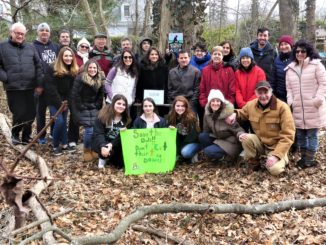
PASCACK VALLEY—Gov. Phil Murphy signed a law on March 20 that requires the state Department of Community Affairs to determine affordable housing obligations for each municipality. The adoption came over the strong reservations from Pascack Valley mayors—Republicans and Democrats—in a joint letter sent to Trenton less than a week before Murphy signed the fast-tracked legislation.
[See also: “Valley mayors seek ‘pause’ on housing mandate,” May 13, 2023]
The bill, A4/S50, signed by Murphy, helps streamline the process for establishing municipal affordable obligations to meet their requirements under a state constitutional mandate to provide their “fair share” of homes and apartments that low and moderate income families can afford.
The state Senate passed the bill, 22–14, along party lines on March 18, and the state Assembly approved amendments added to its version since that chamber passed the bill, 51–28, in February.
In an effort to pause or revise the fast-moving legislation, the 10 town Pascack Valley Mayors Association sent a letter to all state senators and Assembly members, calling for more than a dozen changes in the new law, which mostly went unheeded.
Over a year ago, the mayors also supported legislation that called for a three-year pause in the next round of affordable housing obligations, set to begin in July 2025. The proposal was introduced by Republican Sen. Holly Schepisi. The legislation did not advance out of committee.
The PVMA has represented mayors from 10 communities, including Emerson, Hillsdale, Montvale, Old Tappan, Oradell, Park Ridge, River Vale, Washington Township, Westwood, and Woodcliff Lake since 1966. The organization’s president this year is Westwood’s Ray Arroyo; vice president is Emerson’s Danielle DiPaola.
The new law abolishes the former Council on Affordable Housing (COAH) that was ruled “moribund” by the state Supreme Court in 2015, after 16 years of inaction, and ruled determining future obligations would be done by towns, superior courts, and affordable housing advocate Fair Share Housing Center.
The law creates a panel of three to seven court-appointed experts who will oversee challenges to newly proposed affordable housing numbers, and appropriates $16 million to DCA to help establish the statewide program.
In mid-March, Hillsdale Mayor Michael Sheinfield told Pascack Press that the pending affordable housing law “could be heavily impactful” on towns and “a rather daunting number” could be imposed in the near future.
“We could be with a gun to our head to come up with a number and just roll with it,” said the mayor after attending a meeting where the legislation was discussed.
The new law is based on a prior affordable housing legal decision called the Jacobson Decision made in 2018. Using the law’s formula, the state community affairs department will determine affordable housing numbers for all eligible towns, and these numbers will be published on the DCA’s website by Dec. 1, 2024.
Officials said the DCA would start posting numbers starting in mid-October through early December 2024.
The law uses a formula in Judge Mary Jacobson’s decision, which weighs the amount of developable land, growth in numbers of households, and change in non-residential property values, among others, to determine how much affordable housing is needed in a specific area. Her original decision focused on Mercer County’s West Windsor and Princeton.
Before appealing for changes in the new law, Sheinfield told Pascack Press why the mayors had so many reservations about affordable housing obligations.
“Each municipality in New Jersey faces its own unique challenges. Some have vast amounts of vacant land with the potential for development, while others are more mature, and are virtually fully developed. Ten years ago, municipalities entered Round 3 negotiations with Fair Share Housing to determine the Realistic Development Potential (RDP) for each community. The 10 towns that comprise the Pascack Valley fall into the latter category as more mature and developed communities,” Sheinfield said.
“Nonetheless, our predecessors negotiated in good faith to identify all realistic areas for potential residential development. Fair Share Housing dramatically reduced their initial development numbers because – like us – they realized such large numbers weren’t realistic,” he said.
Sheinfield said the law “will create even larger affordable housing obligations than Round 3 (1999–2025) … Once again, we will be given initial numbers and then we will try to compromise on what is realistic for our towns. If Fair Share Housing thought there was more potential for affordable housing in our communities 10 years ago, they wouldn’t have allowed us to settle on the numbers we did. Buildable land was scarce 10 years ago and is even scarcer now because over the last decade we met our Round 3 obligations.”
The law sets deadlines: Dec. 1, 2024, State DCA publishes towns’ obligation numbers; Jan. 31, 2025, towns must adopt their obligations by binding resolution to be protected from developers’ lawsuits; Feb. 28, 2025.
Challenges can be filed through the affordable housing dispute resolution program; April 1, A resolution to any dispute(s) must be finalized; June 30, Towns must approve Housing Element and Fair Share Plan to meet affordable obligations; Aug. 31, Interested parties can challenge the Fair Share Plan and Housing Element; Dec. 31, 2025, Towns must finish Fair Share Plan or explain why it won’t make changes; March 15, 2026, Towns must adopt changes to local ordinances.
The PVMA’s March 14 letter emailed to all 120 state Assembly and Senate members requested 13 amendments and asked for the pending A4/S50 legislation to be tabled. The law was passed six days later. The mayors had called for these changes:
- The removal of the Urban Aid exemption so that all residents have equal opportunity to obtain affordable housing where they currently live, work, and have their family and friends support network;
- An accounting of how many units can realistically be achieved through inclusionary zoning, and how many units the market can bear, i.e. a market study;
- Clear methodology to determine the State, Zone and municipal obligations, with numbers cited in the bill;
- A straightforward, achievable bonus structure for existing affordable housing that includes credits for preserving environmentally-sensitive land, and counts existing affordable units based upon a municipality’s residents’ actual income;
- Decisive immunity from challenge and developer’s remedy unless the challenger can prove that the municipality is “determined to be constitutionally noncompliant” in accordance with Supreme Court standards;
- A vacant-land adjustment that respects local zoning; and the fully developed nature of a community;
- Methodology to analyze infrastructure capabilities and allow a commensurate adjustment of the allocated unit obligation, or places responsibility to fund upgrades on the developers, not the taxpayers;
- Methodology to analyze existing municipal pervious coverage, the impact the obligated development would have on that coverage and its ability to absorb runoff and mitigate flooding, and an allowance for a reduction in obligation to avoid exacerbating existing flood conditions;
- Removal of the clause mandating realistic zoning for 25% of unmet need which, as currently written, imposes overdevelopment and increases carbon footprint;
- A return to the midway review as opposed to realistic opportunity review that can be requested by anyone at any time, generating unreasonable unfunded legal costs for every municipality;
- Applicability of recently revised DEP flood and stormwater regulations, with additional protections for watershed and environmentally-sensitive land;
- A comprehensive analysis of the added costs the inclusionary 80/20 model puts upon municipal services, and the impact on residents who cannot afford market rate rents (which are becoming increasingly luxury to compensate for the affordable units), yet do not qualify for affordable housing; and
- A realistic timetable for implementing the provisions of the legislation.
- The PVMA also had pressed state legislators to look at how the affordable units are awarded. The new law does not address that concern.
The mayors said, “We also urge you to review the current ‘lottery system’ that rewards the lucky few with housing, rather than providing homes to those that truly need them, when and where they need them. Building tens of thousands of housing units across the state does not guarantee those units will end up in the hands of the homeless, the aged, the financially challenged, the handicapped, the underserved.”
They added, “Nor does it guarantee the dream of home ownership, since the vast majority of units are rental. The apportionment system needs an overhaul every bit as much as A4/S50.”



